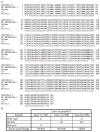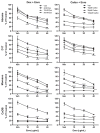Enrofloxacin enhances the effects of chemotherapy in canine osteosarcoma cells with mutant and wild-type p53
- PMID: 27333821
- PMCID: PMC5182190
- DOI: 10.1111/vco.12250
Enrofloxacin enhances the effects of chemotherapy in canine osteosarcoma cells with mutant and wild-type p53
Abstract
Adjuvant chemotherapy improves survival time in dogs receiving adequate local control for appendicular osteosarcoma, but most dogs ultimately succumb to metastatic disease. The fluoroquinolone antibiotic enrofloxacin has been shown to inhibit survival and proliferation of canine osteosarcoma cells in vitro. Others have reported that fluoroquinolones may modulate cellular responses to DNA damaging agents and that these effects may be differentially mediated by p53 activity. We therefore determined p53 status and activity in three canine osteosarcoma cell lines and examined the effects of enrofloxacin when used alone or in combination with doxorubicin or carboplatin chemotherapy. Moresco and Abrams canine osteosarcoma cell lines contained mutations in p53, while no mutations were identified in the D17 cells or in a normal canine osteoblast cell line. The addition of enrofloxacin to either doxorubicin or carboplatin resulted in further reductions in osteosarcoma cell viability; this effect was apparent regardless of p53 mutational status or downstream activity.
Keywords: chemotherapy; comparative oncology; oncology; small animal; tumour biology.
© 2016 John Wiley & Sons Ltd.
Figures






Similar articles
-
The effects of taurolidine alone and in combination with doxorubicin or carboplatin in canine osteosarcoma in vitro.BMC Vet Res. 2013 Jan 18;9:15. doi: 10.1186/1746-6148-9-15. BMC Vet Res. 2013. PMID: 23331343 Free PMC article.
-
Carboplatin versus alternating carboplatin and doxorubicin for the adjuvant treatment of canine appendicular osteosarcoma: a randomized, phase III trial.Vet Comp Oncol. 2016 Mar;14(1):81-7. doi: 10.1111/vco.12069. Epub 2013 Oct 4. Vet Comp Oncol. 2016. PMID: 24118677 Free PMC article. Clinical Trial.
-
Effects of the potassium-sparing diuretic amiloride on chemotherapy response in canine osteosarcoma cells.J Vet Intern Med. 2019 Mar;33(2):800-811. doi: 10.1111/jvim.15382. Epub 2018 Dec 17. J Vet Intern Med. 2019. PMID: 30556178 Free PMC article.
-
Canine osteosarcoma: amputation and chemotherapy.Vet Clin North Am Small Anim Pract. 1996 Jan;26(1):111-21. doi: 10.1016/s0195-5616(96)50010-0. Vet Clin North Am Small Anim Pract. 1996. PMID: 8825570 Review.
-
Canine osteosarcoma: a naturally occurring disease to inform pediatric oncology.ILAR J. 2014;55(1):69-85. doi: 10.1093/ilar/ilu009. ILAR J. 2014. PMID: 24936031 Review.
Cited by
-
A genetically engineered microRNA-34a prodrug demonstrates anti-tumor activity in a canine model of osteosarcoma.PLoS One. 2018 Dec 31;13(12):e0209941. doi: 10.1371/journal.pone.0209941. eCollection 2018. PLoS One. 2018. PMID: 30596759 Free PMC article.
-
DNA damage response proteins in canine cancer as potential research targets in comparative oncology.Vet Comp Oncol. 2022 Jun;20(2):347-361. doi: 10.1111/vco.12795. Epub 2022 Jan 10. Vet Comp Oncol. 2022. PMID: 34923737 Free PMC article. Review.
-
Comparative oncology approach to drug repurposing in osteosarcoma.PLoS One. 2018 Mar 26;13(3):e0194224. doi: 10.1371/journal.pone.0194224. eCollection 2018. PLoS One. 2018. PMID: 29579058 Free PMC article.
-
In vitro and in vivo activity of liposome-encapsulated curcumin for naturally occurring canine cancers.Vet Comp Oncol. 2018 Dec;16(4):571-579. doi: 10.1111/vco.12424. Epub 2018 Aug 8. Vet Comp Oncol. 2018. PMID: 30088848 Free PMC article.
-
The interaction between RUNX2 and core binding factor beta as a potential therapeutic target in canine osteosarcoma.Vet Comp Oncol. 2020 Mar;18(1):52-63. doi: 10.1111/vco.12526. Epub 2019 Aug 22. Vet Comp Oncol. 2020. PMID: 31381810 Free PMC article.
References
-
- Skorupski KA, Uhl JM, Szivek A, Allstadt Frazier SD, Rebhun RB, Rodriguez CO., Jr Carboplatin versus alternating carboplatin and doxorubicin for the adjuvant treatment of canine appendicular osteosarcoma: a randomized, phase III trial. Veterinary and Comparative Oncology. 2016;14:81–87. doi: 10.1111/vco.12069. - DOI - PMC - PubMed
-
- Somekh E, Douer D, Shaked N, Rubinstein E. In vitro effects of ciprofloxacin and pefloxacin on growth of normal human hematopoietic progenitor cells and on leukemic cell lines. Journal of Pharmacology and Experimental Therapeutics. 1989;248:415–418. - PubMed
-
- Melo S, Villanueva A, Moutinho C, Davalos V, Spizzo R, Ivan C, et al. Small molecule enoxacin is a cancer-specific growth inhibitor that acts by enhancing TAR RNA-binding protein 2-mediated microRNA processing. Proceedings of the National Academy of Sciences of the United States of America. 2011;108:4394–4399. doi: 10.1073/pnas.1014720108. - DOI - PMC - PubMed
-
- Aranha O, Grignon R, Fernandes N, McDonnell TJ, Wood DP, Sarkar FH. Suppression of human prostate cancer cell growth by ciprofloxacin is associated with cell cycle arrest and apoptosis. International Journal of Oncology. 2003;22:787–794. - PubMed
MeSH terms
Substances
Grants and funding
LinkOut - more resources
Full Text Sources
Other Literature Sources
Medical
Research Materials
Miscellaneous

